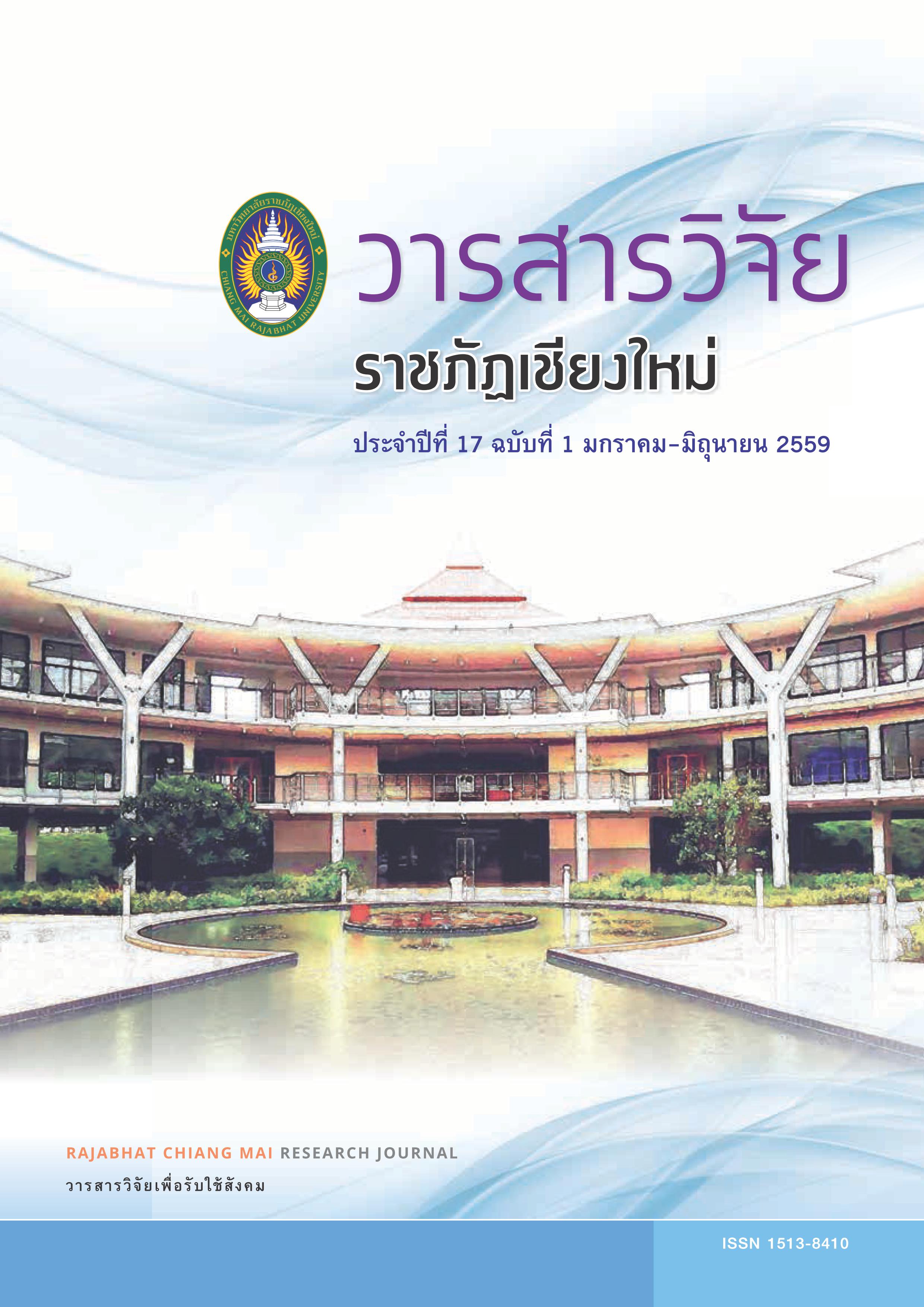การประยุกต์ใช้เทคโนโลยีสารสนเทศสำหรับการศึกษาในด้านการอนุรักษ์ภูมิปัญญาท้องถิ่น ในพื้นที่เทศบาลเมืองเมืองแกนพัฒนา อำเภอแม่แตง จังหวัดเชียงใหม่
DOI:
https://doi.org/10.14456/rcmrj.2016.214852คำสำคัญ:
เทคโนโลยีสารสนเทศสำหรับการศึกษา, การอนุรักษ์ภูมิปัญญาท้องถิ่นบทคัดย่อ
โครงการวิจัยเรื่อง การประยุกต์ใช้เทคโนโลยีสารสนเทศสำหรับการศึกษาในด้านการอนุรักษ์ภูมิปัญญาท้องถิ่น ในพื้นที่เทศบาลเมืองเมืองแกนพัฒนา อำเภอแม่แตง จังหวัดเชียงใหม่ มีวัตถุประสงค์หลัก เพื่อรวบรวมข้อมูลภูมิปัญญาท้องถิ่น เพื่อสร้างสื่อการเรียนรู้ด้านการอนุรักษ์ภูมิปัญญาท้องถิ่น โดยกระบวนการมีส่วนร่วมกับนักเรียนในชุมชน และผู้วิจัย เพื่อเผยแพร่สื่อการเรียนรู้บนเครือข่ายอินเทอร์เน็ตให้แก่นักเรียนในชุมชน และเพื่อประเมินผลสัมฤทธิ์ของสื่อการเรียนรู้ด้านการอนุรักษ์ภูมิปัญญาท้องถิ่น กลุ่มตัวอย่างที่ใช้ในการศึกษาครั้งนี้ ได้แก่ กลุ่มผู้ให้ข้อมูลด้านภูมิปัญญาท้องถิ่น จำนวน 19 คน กลุ่มผู้เสนอแนะรูปแบบวิธีการจัดเก็บข้อมูลภูมิปัญญาท้องถิ่น และการสร้างสื่อด้านภูมิปัญญาท้องถิ่น จำนวน 22 คน และกลุ่มตัวอย่างสำหรับการประเมินการใช้งานระบบ และประเมินคุณภาพสื่อ จำนวน 53 คน เก็บรวบรวมข้อมูลด้วย การสัมภาษณ์ การจัดเวที ประเมินการใช้งานระบบด้วยแบบสอบถาม และแบบทดสอบก่อนเรียน หลังเรียน วิเคราะห์ข้อมูลด้วยสถิติ ความถี่ ร้อยละ เปรียบเทียบความแตกต่างของค่าคะแนนความรู้ด้วยการทดสอบค่า t-test ซึ่งงานวิจัยได้เก็บรวมรวมข้อมูลภูมิปัญญาภายในท้องถิ่น ประกอบด้วย ภูมิปัญญาการเพาะเห็ดโคนน้อย ภูมิปัญญาการจัดทำโคมไฟ 700 ปี ภูมิปัญญากังหันวิดน้ำ ภูมิปัญญาด้านพิธีกรรมพื้นบ้านล้านนา และการเขียนตัวหนังสือเมือง ภูมิปัญญาช้างกระดาษสา ภูมิปัญญาการตีมีด ภูมิปัญญาการจ่อตอง และดำเนินการจัดทำระบบสารสนเทศสำหรับการศึกษาเพื่อเก็บรวบรวมข้อมูลภูมิปัญญาท้องถิ่นไว้เป็นระบบสารสนเทศ และจัดทำสื่อการเรียนรู้ด้านการอนุรักษ์ภูมิปัญญาท้องถิ่น ซึ่งสามารถนำไปใช้ประโยชน์ในการจัดการเรียนรู้สำหรับนักเรียนในชุมชน และเผยแพร่ระบบสารสนเทศสำหรับการศึกษาในด้านการอนุรักษ์ภูมิปัญญาท้องถิ่นบนเครือข่ายอินเทอร์เน็ต โดยการมีส่วนร่วมกับชุมชนเป็นการอนุรักษ์ภูมิปัญญาท้องถิ่นแบบยั่งยืน
ผลการวิจัยได้สอบถามความพึงพอใจการใช้งานระบบของกลุ่มตัวอย่าง จำนวน 2 โรงเรียน และกลุ่มผู้ให้ข้อมูลภูมิปัญญา พบว่า ผู้ใช้มีระดับความพึงพอใจอยู่ในเกณฑ์มาก และการวัดผลสัมฤทธิ์ทางการทดสอบก่อนเรียนและหลังเรียน ของนักเรียนทั้ง 2 โรงเรียน พบว่า คะแนนเฉลี่ยหลังเรียนเพิ่มขึ้นจากคะแนนก่อนเรียน คิดเป็นร้อยละ 57.27 ผลการเปรียบเทียบผลสัมฤทธิ์ทางการเรียนระหว่างก่อนเรียน และหลังเรียน ปรากฏว่าคะแนนแบบทดสอบหลังเรียนสูงกว่าคะแนนแบบทดสอบก่อนเรียน อย่างมีนัยสำคัญทางสถิติที่ระดับ 0.05
Downloads
เอกสารอ้างอิง
ธีรศานต์ ไหลหลั่ง. (2549). การออกแบบประเมินชุดสื่อมัลติมีเดียวิชาการถ่ายภาพทางการศึกษาตามโมเดลการออกแบบของกานเยและบริกส์. วิทยานิพนธ์ครุศาสตร์อุตสาหกรรมมหาบัณฑิต บัณฑิตวิทยาลัย สถาบันเทคโนโลยีพระจอมเกล้าพระนครเหนือ.
นพคุณ ชูทัน. (2558). การพัฒนาสารสนเทศเพื่อการอนุรักษ์ภูมิปัญญาสถาปัตยกรรมเมืองมรดกโลก จังหวัดกำแพงเพชร. วารสารวิชาการ ศิลปะสถาปัตยกรรมศาสตร์ มหาวิทยาลัยนเรศวร, 6(2), 1-18.
มณีวรรณ จันที. (2553). การพัฒนาบทเรียนอิเล็กทรอนิกส์บนเครือข่ายอินเทอร์เน็ต เรื่องการวิเคราะห์โครงการลงทุน. วิทยานิพนธ์บริหารธุรกิจมหาบัณฑิต บัณฑิตวิทยาลัย มหาวิทยาลัยเชียงใหม่.
วิลาวัณย์ เดือนราษฎร์, รังสิยา นารินทร์, วรากรณ์ บุญเชียง, ศิวพร อึ้งวัฒนา และ สุกิจ เตือนราษฎร์. (2551). การพัฒนาสื่อการเรียนการสอนด้วยบทเรียนโปรแกรมคอมพิวเตอร์ช่วยสอนกระบวนวิชา 551485 การรักษาโรคเบื้องต้น. วารสารวิทยาลัยพยาบาลพระปกเกล้า จันทบุรี, 19(2), 1-11.
ดาวน์โหลด
เผยแพร่แล้ว
รูปแบบการอ้างอิง
ฉบับ
ประเภทบทความ
สัญญาอนุญาต
1. บทความ ข้อมูล เนื้อหา รูปภาพ ฯลฯ ที่ได้รับการตีพิมพ์ใน “Community and Social Development Journal” ถือเป็นลิขสิทธิ์ของ Community and Social Development Journal มหาวิทยาลัยราชภัฏเชียงใหม่ และเพื่อให้เผยแพร่บทความได้อย่างเหมาะสมผ่านสื่อสิ่งพิมพ์และอิเล็กทรอนิกส์ ผู้เขียนยังคงถือครองลิขสิทธิ์บทความที่ตีพิมพ์ภายใต้ใบอนุญาต Creative Commons Attribution (CC BY) ซึ่งอนุญาตให้เผยแพร่บทความซ้ำในแหล่งอื่นได้ โดยอ้างอิงต้องอ้งอิงบทความในวารสาร ผู้เขียนต้องรับผิดชอบในการขออนุญาตผลิตซ้ำเนื้อหาที่มีลิขสิทธิ์จากแหล่งอื่น
2. เนื้อหาบทความที่ปรากฏในวารสารเป็นความรับผิดชอบของผู้เขียนบทความโดยตรง ซึ่งกองบรรณาธิการวารสารไม่จำเป็นต้องเห็นด้วยหรือร่วมรับผิดชอบใดๆ














